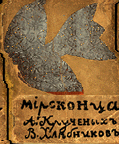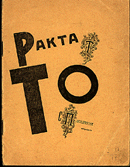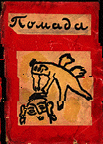FUTURIST BOOKS
 |
 |
 |
|

 |
 |
 |
|
The Futurists broke with tradition and questioned the accepted concepts of what constitutes art. Yet their work was consciously derived from Renaissance illuminated manuscripts, Cubism, and prehistoric cave paintings. They published manifestos in the form of pamphlets, and books of illustrated poetry. In Italy they were led by Marinetti, who published his first manifesto in 1909. In Russia there were several groups of artists and poets, including the Union of Youth in St. Petersburg and the Donkey's Tail group in Moscow (named after a group of French artists who had tied a paintbrush to a donkey's tail and submitted the resulting painting to an exhibition), and the Hylaea group (named after an ancient region near the black sea which predated classical Greek culture).In 1912 writer Aleksei Kruchenykh and the artist Mikhail Larionov produced a lithographed, handwritten and illustrated book titled Old-time Love. The publishers, or sponsors, of this book were Georgy Kuzmin and Sergei Dolinsky, who provided the radical artists and poets with the means to do as they pleased. It was a blend of self-publishing and patronage. They soon followed with anthologies of the "Donkey's Tail" group, including Worldbackwards and one which took its title from the manifesto written for it by David Burliuk, A Slap in the Face of Public Taste. In 1913 Kruchenykh and Larionov produced Pomade, with a mimeographed text and hand colored lithographs.
Prominent Futurists include the writers Vasily Kemensky, Elena Guro, and Velimir Khlebnikov and artists Vladimir Mayakovsky, Nataliya Goncharova and Kazimir Malevich. By using configurations of type which related to the images evoked by the poems, they created a form of concrete and visual poetry. The typographic experimentation of this period has had a lasting inluence on page design. Kiril Zdanevich and Igor Terentyev's 1920 Treatise on Total Indecency continues to have an impact on the typography of contemporary artists
Several of the major 20th century developments grew out of this movement. In Russia, Alexsandr Rodchenko and El Lissitzky (who moved to Berlin) continued to evolve the geometric visuals born of the Cubist foundation, and became the Constructivists. Rodchenko's cover for the Futurist poets' book Transrationalists is an early example of Constructivist deign. Vasily Kandinsky, who left Russia for Munich, was included in the Futurist books, published Der Blaue Reiter, and through his books and his teaching at the Bauhaus was a major influence on 20th century art and design. Tristan Tzara led the Dadaists in Zurich, and Marcel Duchamp in France.
See how letterforms were used as illustration and pages designed as a totality in an Egyptian papyrus
See an Arabic illuminated manuscript
Look at a Hebrew illuminated manuscript
Look at Fluxus work which was influenced by the Futurist aesthetic
Look at other forms of writer and artist collaborations in the twentieth century
Photos thanks to Howard Schickler Fine Art, where you can find Russian books of this period.